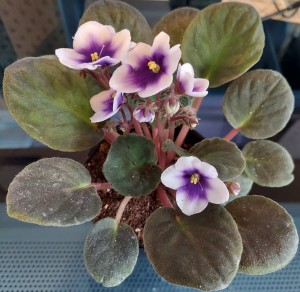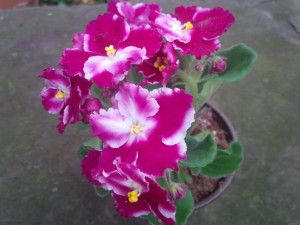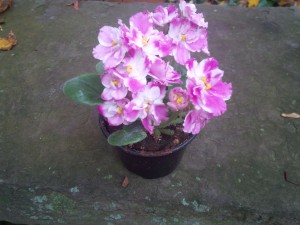 Like most couples, my parents compromised on various issues throughout their marriage. One of the most significant centered on flowers. My mother wanted flowers in the house 365 days a year. My father did not want to go broke providing them. The compromise, which took place before I was old enough to know about it, was that during the growing season, those flowers would come from my father’s garden. At other times they would come from the lighted plant area in the basement of our house. On special occasions they came from the local florist.
Like most couples, my parents compromised on various issues throughout their marriage. One of the most significant centered on flowers. My mother wanted flowers in the house 365 days a year. My father did not want to go broke providing them. The compromise, which took place before I was old enough to know about it, was that during the growing season, those flowers would come from my father’s garden. At other times they would come from the lighted plant area in the basement of our house. On special occasions they came from the local florist.
The plant area was a bench, about seven feet long and three feet wide, illuminated by overhead plant lights. As far as I know, my father built it himself, though he was not very handy with tools and had an absolute knack for making power tools sputter and die. The plant bench was very simple in design, which probably accounted for its birth at my father’s hands.
The bench was home to all kinds of indoor plants, but the most common by far were African violets, known to plant taxonomists as Saintpaulia ionantha. These days, African violets are cheap and ubiquitous, available everywhere from supermarkets to big box stores. Every once in awhile, I even see them in a special display at the local Quik Check. Many of those plants, especially the trademarked Optimara violets, come from the world’s largest African violet supplier, Herman Holtkamp Greenhouses in Nashville, Tennessee.
I don’t know where my father got his violets—probably from a local greenhouse. Most of them bore purple flowers, though I recall at least one with pink blooms. All were fertilized with a mixture that came in a purple glass bottle that lived by the plant bench. Those violets enjoyed cosseted lives in the cellar until bloom time rolled around, when they would be positioned in places of honor upstairs. When the petals fell they would be returned to the cellar to regain strength for their next above-ground appearance.
The ancestors of modern African violets did indeed live on the African continent, in mountainous regions of today’s Kenya and Tanzania. Though the flowers bear a superficial resemblance to those of members of the violet or Violaceae family, African violets are not related to them. They are gesneriads, belonging to the Generiaceae family along with other popular blooming houseplants, like streptocarpus and gloxinia.
Like other gesneriads, African violets produce rosettes of evergreen leaves. Those leaves are rounded, somewhat fleshy and covered with soft hairs. The flowers are borne on slender stalks and have five petals apiece—two upper petals and three, slightly larger lower ones. The petals may appear equal on many modern violet varieties. If you look at the flowers closely, you will notice that the petals’ bases fuse into a tube, another gesneriad characteristic.
In the nineteenth century, cradles of biodiversity in Africa, South America and Asia were rife with European colonizers, some of whom were keen amateur or even professional botanists.  One such amateur was Prussian nobleman Walter von Saint Paul-Illaire, who, during the eighteen nineties, served as a bureaucrat for the German East Indian Company. Hiking through the Usambara mountains of eastern Tanzania, he discovered the low-growing plants that were eventually named in his honor. The baron sent seeds back to Europe and the saintpaulia craze began. It has not abated since.
One such amateur was Prussian nobleman Walter von Saint Paul-Illaire, who, during the eighteen nineties, served as a bureaucrat for the German East Indian Company. Hiking through the Usambara mountains of eastern Tanzania, he discovered the low-growing plants that were eventually named in his honor. The baron sent seeds back to Europe and the saintpaulia craze began. It has not abated since.
Because my father was such an avid African violet grower, I took the plants for granted. Now, long after his death, I find myself wanting them. Sentiment is an imperfect growing medium, so I am lucky that African violets are relatively unfussy and thrive in indoor situations where light is somewhat less than optimal. All you really need is a warm room, bright diffuse light and well-drained potting soil, as African violets dislike wet feet. Water only when the soil surface feels dry to the touch. The descendants of that purple bottle of plant food that my father used are still available in stores and still packaged in purple. Your African violets will appreciate regular applications according to manufacturers’ directions.
While choice is limited in most commercial establishments, the African violet world is full of options. Breeders have created large varieties that may be up to 12 inches in diameter, as well as minis that span only six inches. Trailing varieties, suitable for pedestals and baskets, are also available. Blooms may be single, double or simply appear as burst of exuberantly ruffled petals. Flower colors range from white through pink, a host of purples, pale green and even yellow. Some varieties sport bi-colored petals and others feature variegated foliage.
I was going to put “African violets” on my Christmas gift wish list, but I will probably order a couple right now while the iron of inspiration is white hot. If you want to follow suit, try The Violet Barn, PO Box 9, Naples, NY 14512; (585) 374-8592; www.violetbarn.com. 
